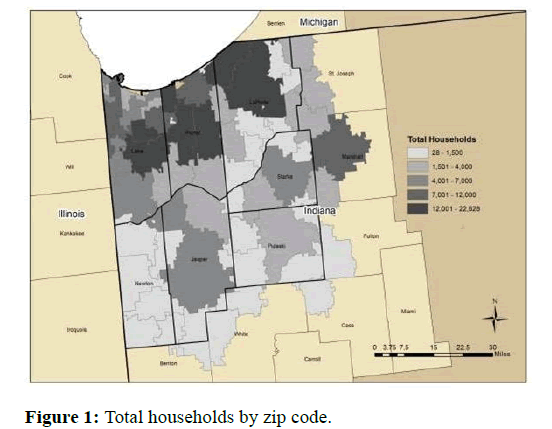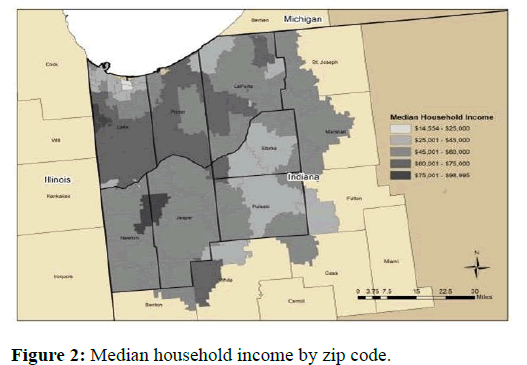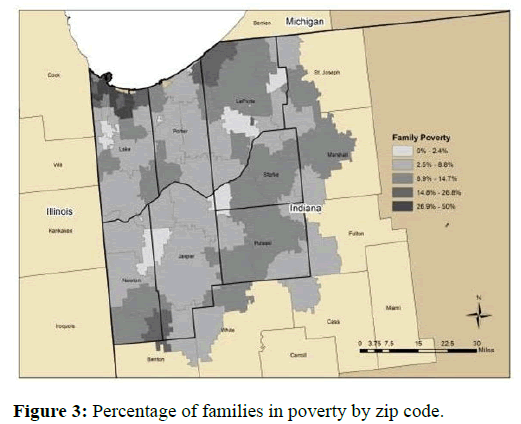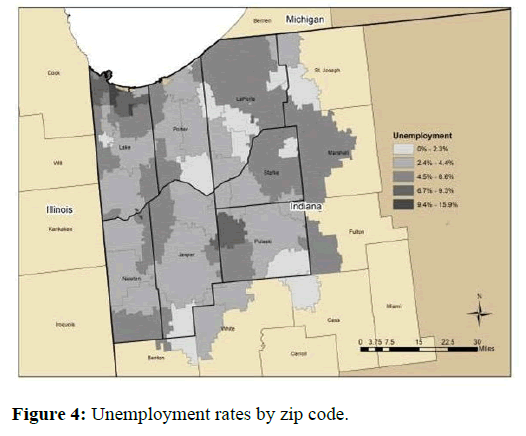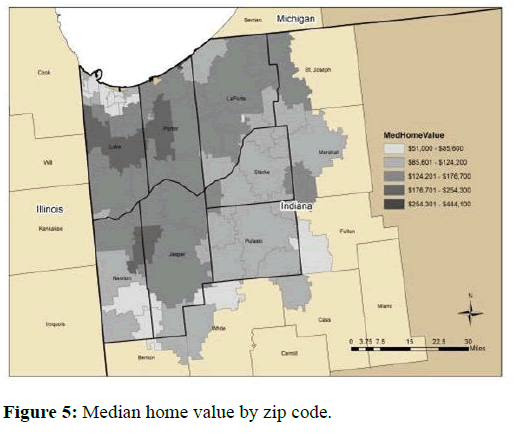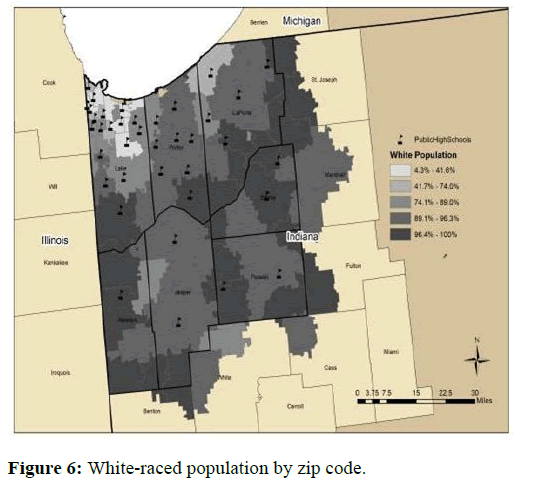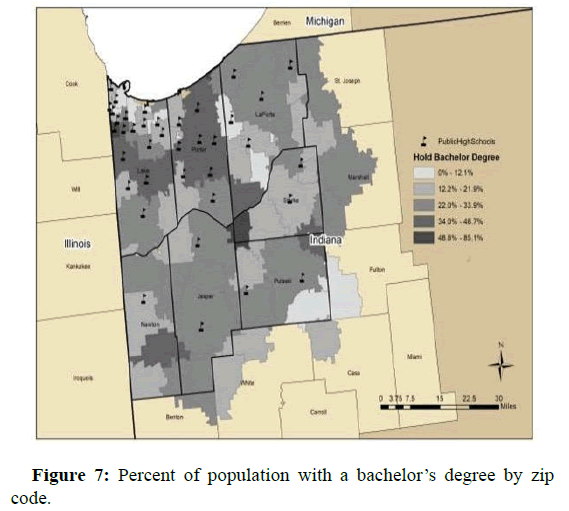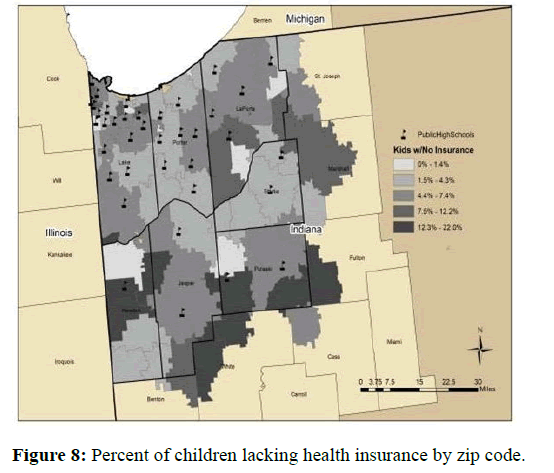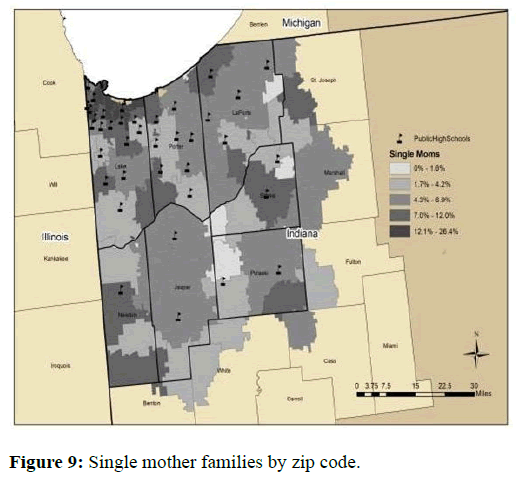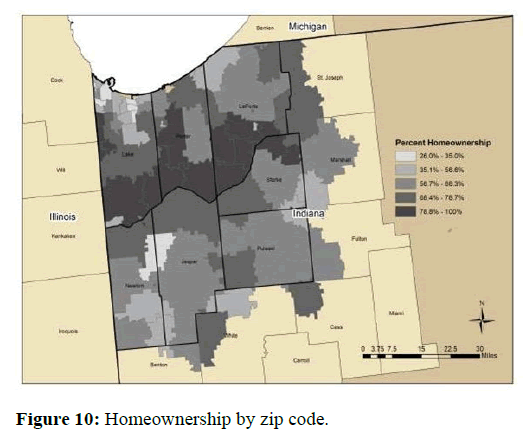Research Article, Res J Econ Vol: 7 Issue: 4
Understanding the Socioeconomic and Demographic Factors which Impact Public Policy in Northwest Indiana
Amlan Mitra*
Department of Economics, Purdue University, West Lafayette, United States
- *Corresponding Author:
- Amlan Mitra
Department of Economics,
Purdue University,
West Lafayette,
United States;
E-mail: Mitraa@pnw.edu
Received date: 04 February, 2020, Manuscript No. RJE-23-7062; Editor assigned date: 07 February, 2020, PreQC No. RJE-23-7062 (PQ); Reviewed date: 21 February, 2020, QC No. RJE-23-7062; Revised date: 12 July, 2023, Manuscript No. RJE-23-7062 (R); Published date: 09 August, 2023, DOI: 10.4172/RJE.1000156
Citation: Mitra A (2023) Understanding the Socioeconomic and Demographic Factors which Impact Public Policy in Northwest Indiana. Res J Econ 7:4.Volume 7
Abstract
Previously the home of farmland and steel industry, Northwest Indiana has been transitioning into a region of exurbs, suburbs and small cities bordering Lake Michigan and the Chicago metropolitan area. Much of this transition has occurred haphazardly and now there is more interest in the planned development of the region. Thus, a comprehensive census and identification of factors to be considered in this development are prudent for the future success of the region. The purpose of this study is to understand the socioeconomic, demographic and educational characteristics of the region to assist policymakers, business interests and other stakeholders with planning for the future of Northwest Indiana. Measures of population, educational attainment, economic stability, and community demographics will be described and analyzed through geospatial mapping. A preliminary econometric analysis to identify any significant relationships among these community variables and local high school graduation rates will be conducted and discussed. As a result of this cross-sectional study, local and regional scholars, community members and regional planning bodies will have a single source of geospatial data and policy recommendations to inform development initiatives in Northwest Indiana.
Keywords: Socioeconomic, Demographic, Education, Population
Introduction
Population characteristics of Northwestern Indiana
Northwest Indiana is sometimes divided into two clusters. The northern counties of Lake, Porter and LaPorte each border Lake Michigan, have hundreds of thousands of residents and larger towns and cities. Lake, Porter and LaPorte are more racially and economically diverse than the other counties in the region. Hammond, Gary, Crown point, Michigan city, Portage and Valparaiso are of the larger population centers in these counties. In contrast, the counties of Jasper, Newton, Pulaski and Starke are largely rural with their agricultural industry now underutilized.
Once the home of many steel manufacturing plants which anchored the region, Northwest Indiana began an economic decline in the 1970s. While steel remains an industry in the region, it now serves a different market and has higher requirements for employee entry. Throughout Northwest Indiana, the median income has declined and poverty and unemployment have increased. Flight of wealthier and white families to the suburbs and rural areas has left racially segregated cities in the region, especially in lake and porter counties [1].
This trend has resulted in Latinx near majority in some parts of Lake and Porter counties. Of this population, many were employed in manufacturing and other laborious occupations such as the RV industry. Latinx families who emigrated to the region for employment and educational opportunities suffered with the recession of 2008. Those who are undocumented have had more trouble recovering in the region, must pay out-of-state tuition for higher education and express a constant fear of deportation.
Lake county which is designated as medically underserved, is also home to many African Americans. This population of Lake county experiences higher unemployment and poverty rates than whites of Lake county, contributing to a stressful experience of African Americans there. Life is also stressful for white, rural residents, many of whom have lower median incomes and diminished access to social services. Northwest Indiana is hard hit by the opioid epidemic with an increase in fatal poisonings in recent years. The demographic group most effected by opioid abuse are white, middle-aged males. In the rural counties of the region, the population is over 95% white [2].
Since the turn of the century, the regional population trend has reversed as residential overflow from the Chicago metropolitan area has occurred. Affordable property, taxes and the proximity of Northwest Indiana to Chicago driven the recent development of the region as an exurb. Exurbs are located beyond the suburbs of a major city, but still retain a connection to the urban center. The exurban community of Northwest Indiana is challenged to provide new domestic migrants with adequate infrastructure, business and employment opportunities, education and otherwise meet basic resident needs. The Northwest Indiana regional development authority has formed for these purposes.
There have been recent efforts to develop the region, some coordinated. Planners and government officials have sought to attract businesses through lower taxes. Some communities have been redesigned especially for sustainability which is support the by natural resources, amenities and resources in the area. A comprehensive regional development plan was commissioned of TIP strategies and the recommendations of this focus on growing the labor market. Although the methods of the TIP strategies study were different from this study, many of the findings and recommendations of this study echo what TIP strategies found [3].
Indiana property taxes were capped through a constitutional amendment in 2008. This action may attract potential business and homeowners, but property taxes are a major source of school funding. State funding is supposed to make up the funding of schools in areas with lower tax revenue. However, funding lost by school districts due to the new system is in the millions with larger deficits in urban districts of the region.
Research of educational outcomes which are a measure of human capital potential has demonstrated relationships between socioeconomic characteristics of a community, specifically, family poverty, gender, race and family structure. Further, high school completion has an inverse relationship to income inequality and a student’s relationship with people who are college educated has a positive relationship to high school graduation rates. This study will determine if similar relationships exist in the Northwest Indiana region between demographic variables and educational outcomes [4].
Materials and Methods
This study seeks to describe the geographic distribution of demographic variables in Northwest Indiana significant to long-term regional development such as population, income, unemployment, educational attainment and homeownership. Further, this study conducts a preliminary analysis of variables significant in local high school graduation rates as a measure of future human capital potential in the region.
Data collected in 2016 through the American community survey are used as demographic, economic and social variables studied. Specific variables analyzed are the population at the county level. Also, the average household size, median household income, family poverty rate, unemployment rate, median home value, percentage white population, attainment of bachelor’s degree, medically uninsured children, single mothers and homeownership, all collected at the zip code level. Census data was first cleaned in excel, then exported to ArcGIS for geospatial analysis.
High school graduation data for the year 2017 was obtained through the Indiana department of education; 48 public high schools were included in the analysis. These data were cleaned initially in excel and organized by zip code. Descriptive statistics and correlation analyses of all data were conducted in STATA [5].
Results
Population and economic variables
Table 1 shows basic descriptive statistics of the population and income-related variables for the Northwest Indiana region, by county. Lake County has the largest population at 489,698 and Pulaski county has the smallest population at 12,910. The region hosts 851,169 people with a mean household size of 2.54. Figure 1 shows that these households are more heavily geographically distributed in Lake, Porter and LaPorte Counties. Newton, Jasper, Pulaski and Starke counties are more rural, thus have lower populations (Table 1 and Figure 1) [6].
| County | Household size | Median HH income | Family poverty | Unemployment | Median home value | |
|---|---|---|---|---|---|---|
| Jasper Pop=33,461 (n=10) | High | 2.83 | $63,750.00 | 16.40% | 6.80% | $156,900.00 |
| Low | 2.41 | $41,039.00 | 0.00% | 1.50% | $79,300.00 | |
| Mean | 2.64 | $52,090.60 | 7.53% | 3.69% | $114,850.00 | |
| S.D. | 0.16 | $7,247.20 | 5.11% | 1.54% | $30,589.51 | |
| Lake Pop=489,698 (n=27) | High | 3.12 | $98,955.00 | 43.7% | 6.1% | $254,300.00 |
| Low | 2.16 | $16,126.00 | 0.00% | 2.1% | $51,000.00 | |
| Mean | 2.63 | $49,242.85 | 16.08% | 6.82% | $118,303.70 | |
| S.D. | 0.2 | $20,318.47 | 12.71% | 3.03% | $58,314.19 | |
| LaPorte Pop=110,993 (n=14) | High | 2.95 | $74,828.00 | 20.20% | 8.2% | $172,900.00 |
| Low | 2.01 | $34,286.00 | 0.00% | 1.4% | $68,000.00 | |
| Mean | 2.51 | $55,649.64 | 8.85% | 0.04% | $130,928.57 | |
| S.D. | 0.23 | $12,886.18 | 6.37% | 2.17% | $27,581.00 | |
| Newton Pop=14,022 (n=7) | High | 2.95 | $80,560.00 | 12.7% | 11.1% | $251,600.00 |
| Low | 1.69 | $35,694.00 | 0.00% | 0.00% | $70,600.00 | |
| Mean | 2.27 | $54,707.43 | 3.43% | 4.89% | $127,042.86 | |
| S.D. | 0.45 | $17,632.50 | 4.93% | 3.32% | $62,592.30 | |
| Porter Pop=167,016 (n=8) | High | 2.79 | $74,682.00 | 12.8% | 5.1% | $441,000.00 |
| Low | 1.89 | $54,926.00 | 0.00% | 1.3% | $116,000.00 | |
| Mean | 2.57 | $66,096.88 | 6.04% | 3.7% | $191,075.00 | |
| S.D. | 0.29 | $7,218.19 | 4.60% | 1.33% | $105,386.67 | |
| Pulaski Pop=12,910 (n=9) | High | 4.14 | $53,750.00 | 50.00% | 6.6% | $108,100.00 |
| Low | 1.38 | $14,554.00 | 0.00% | 0.00% | $62,500.00 | |
| Mean | 2.53 | $38,738.22 | 12.39% | 3.22% | $88,185.71 | |
| S.D. | 0.71 | $13,599.46 | 14.66% | 2.35% | $15,603.57 | |
| Starke Pop=23,069 (n=6) | High | 2.83 | $57,083.00 | 13.30% | 6.1% | $13,200.00 |
| Low | 2.46 | $40,746.00 | 6.60% | 1.6% | $97,800.00 | |
| Mean | 2.64 | $46,924.33 | 10.22% | 4.63% | $111,516.67 | |
| S.D. | 0.13 | $5,810.36 | 2.83% | 1.59% | $13,935.63 | |
| Region Pop=851,169 (n=81) | High | 4.14 | $98,955.00 | 50.0% | 1.11% | $441,000.00 |
| Low | 1.38 | $14,554.00 | 0.00% | 0.00% | $51,000.00 | |
| Mean | 2.54 | $46,048.00 | 9.22% | 4.42% | $125,986.07 | |
| S.D. | 0.13 | $19,529.28 | 4.18% | 1.2% | $31,841.73 | |
Table 1: Population and economic variables in the Northwest Indiana region, by zip code and county, 2016 (n=81).
In the region, the median household income is $46,048. Table 1 and Figure 2 show that incomes above this are more prevalent in Jasper, Lake, LaPorte, Newton, Porter and Starke counties. The median income in Pulaski county and several zip codes in Lake county are significantly lower than the regional average. The measure of family poverty accounts for family size and in the NWI region, it ranges from 0%-50%. Table 1 and Figure 3 show that areas of family poverty over 9.9% occur in each of the seven counties and Lake (16.08%), Pulaski (12.93%) and Starke counties have the highest averages (10.22%) [7].
As shown in Table 1 and Figure 4, regional unemployment is 4.42% and the reported high of this variable is in Newton County (11.10%). Lake County has the highest average unemployment rate of 6.82%. The median home value in the region, shown in Figure 5, is $125,986.07 and counties with an average above this value are LaPorte ($130,928), Newton ($127,043) and Porter ($191,075). In other states, property values are a determinant of school funding, but in Indiana, this variable plays a diminished role because only 1% of property taxes can go towards school funding because of recent legislation (Figures 4 and 5) [8].
Educational outcomes and related variables
Table 2 shows basic descriptive statistics of demographic variables for the Northwest Indiana region, by county. These demographic variables have been shown through previous studies to have correlation to educational outcomes. The Pearson correlation coefficients of these demographic variables and in relationship to the 2017 regional high school graduation rates are found in Tables 2 and 3 [9].
| County | White population | Earned bachelor’s | Uninsured children | Single mothers | Home-ownership | |
|---|---|---|---|---|---|---|
| Jasper schools grads=93.1% (n=2) | High | 99.00% | 71.90% | 21.0% | 7.33% | 76.1% |
| Low | 85.30% | 15.10% | 2.00% | 0.00% | 53.96% | |
| Mean | 95.18% | 32.46% | 9.17% | 3.94% | 66.29% | |
| S.D. | 4.08% | 19.97% | 6.51% | 2.19% | 8.71% | |
| Lake schools grads=84.4% (n=23) | High | 100.00% | 73.00% | 14.00% | 26.40% | 94.47% |
| Low | 4.3% | 6.20% | 0.00% | 2.14% | 26.03% | |
| Mean | 61.89% | 23.39% | 5.32% | 10.57% | 57.97% | |
| S.D. | 31.31% | 15.00% | 3.04% | 6.32% | 19.13% | |
| LaPorte schools grads=90.7% (n=6) | High | 100.00% | 36.30% | 10.90% | 1.0% | 92.27% |
| Low | 71.2% | 7.60% | 0.00% | 0.00% | 53.54% | |
| Mean | 93.23% | 19.13% | 5.79% | 5.66% | 72.89% | |
| S.D. | 0.0899% | 8.46% | 3.44% | 3.3% | 11.05% | |
| Newton schools grads=86.0% (n=2) | High | 100.00% | 33.90% | 19.8% | 9.03% | 100.00% |
| Low | 8.99% | 1.90% | 0.00% | 0.00% | 29.27% | |
| Mean | 97.89% | 17.15% | 10.10% | 3.51% | 68.41% | |
| S.D. | 3.98% | 11.88 | 8.41% | 3.83% | 21.72% | |
| Porter schools grads=87.9% (n=10) | High | 98.00% | 8.51% | 5.40% | 10.75% | 82.54% |
| Low | 85.4% | 5.3% | 0.00% | 0.00% | 45.6% | |
| Mean | 93.55% | 36.54% | 2.36% | 5.59% | 67.75% | |
| S.D. | 4.19% | 24.28% | 1.86% | 3.43% | 13.85% | |
| Pulaski Schools Grads=91.7% (n=2) | High | 100.00% | 45.4% | 22.00% | 7.89% | 81.82% |
| Low | 95.5% | 0.00% | 0.00% | 0.00% | 50.00% | |
| Mean | 98.39% | 19.19% | 9.64% | 4.03% | 65.22% | |
| S.D. | 1.91% | 14.52% | 7.7% | 2.74% | 10.53% | |
| Starke schools grads=91.1% (n=3) | High | 97.40% | 31.2% | 12.2% | 7.88% | 85.00% |
| Low | 91.00% | 16.10% | 2.20% | 0.00% | 46.15% | |
| Mean | 94.93% | 22.45% | 4.30% | 4.40% | 68.23% | |
| S.D. | 2.37% | 5.14% | 3.89% | 2.63% | 14.21% | |
| Regional schools grads=87.0% (n=48) | High | 100.00% | 85.10% | 22.00% | 2.64% | 100.00% |
| Low | 4.30% | 0.00% | 0.00% | 0.00% | 26.03% | |
| Mean | 90.72% | 24.33% | 6.67% | 5.39% | 66.68% | |
| S.D. | 12.87% | 7.35% | 2.99% | 2.43% | 4.53% | |
Table 2: Select educational and demographic variables in the Northwest Indiana region, by zip code and county, 2016-2017 (n=48, 81).
| Graduation rates | White population | Earned bachelors | Uninsured children | Single moms | Poverty | Home- ownership | |
|---|---|---|---|---|---|---|---|
| Graduation rates | 1 | - | - | - | - | - | - |
| White population | 0.41 | 1 | - | - | - | - | - |
| Earned bachelors | 0.29 | 0.5 | 1 | - | - | - | - |
| Uninsured children | 0.13 | 0.18 | -0.13 | 1 | - | - | - |
| Single moms | -0.45 | -0.92 | -0.56 | -0.08 | 1 | - | - |
| Family poverty | -0.44 | -0.92 | -0.59 | -0.14 | 0.93 | 1 | - |
| Home-ownership | 0.44 | 0.89 | 0.55 | 0.05 | -0.92 | -0.94 | 1 |
Table 3: Pearson correlation coefficients between 2017 high school graduation rates and demographic variables of Northwest Indiana (n=48).
Table 2 and Figure 6 show a lower distribution of white-raced population in Northern Lake County with some zip codes having less than 10% of the population identifying as white. Regionally, 90.72% of the population is white and Jasper, LaPorte, Newton, Porter, Pulaski and Starke Counties are each more than 90% white. The percentage of population which is white-raced has a positive and moderate correlation to high school graduation rates (r=0.41) in the region [10].
Figure 7 shows the distribution of adult educational attainment in the region. On average, 24.33% of the population has earned a bachelor’s degree or above. Less than 20% of the population in LaPorte (19.13%), Newton (17.15%) and Pulaski county (19.19%) has earned a bachelor’s degree. The percentage of population which has earned a bachelor’s degree has a positive and moderate correlation to high school graduation rates (r=0.29) in the region (Figures 6 and 7).
Within NWI, an average of 6.67% of children are medically uninsured. This rate grows as high as 22% in Pulaski county and the average rate of medically uninsured children is over 10% in Newton (10.10%) and Starke counties (12.20%). Figure 8 shows that there are areas in each county where uninsured children reside. The percentage of children which are medically uninsured has a weak correlation to high school graduation rates in the region. Across the region, 5.39% of the families are headed by single mothers and this is much higher in Lake County (10.57%), as shown in Figure 9. The percentage of single mothers has a negative and moderate correlation to high school graduation rates (r=-0.45) in the region (Figures 8 and 9).
Figure 10 and Table 2 show that the amount of homeownership in the region averages to 66.68%, with the highest rates in the southern parts of lake, porter and laporte counties. However, the lowest rates of homeownership are also in Lake, Newton and Jasper Counties. The percentage of homeownership has a positive and moderate correlation to high school graduation rates (r=0.44). The percentage of family poverty, described in Table 1 and Figure 3, has a negative and moderate correlation to high school graduation rates in the region (r=-0.44) (Figure 10) [11].
Discussion
In Northwest Indiana, the counties of Lake, LaPorte and Porter are similar due to their larger population, urban character and proximity to the Chicago metropolitan area via major highways. Of the economic measures in these three counties, Porter has the lowest measures of unemployment and family poverty and the highest median household income and home value. Major industries employing residents of porter county are manufacturing, health care and social services and many of these opportunities are outside of the Northwest Indiana region. One measure of future of porter county is their high school graduation rate which is 87.9% for the 2016-2017 school years; slightly higher than the regional average. Of the variables with positive and negative correlation with high school graduation rates, Porter county is better than the regional average. Laporte County is less economically healthy than Porter, with a lower median household income, a lower median home value and higher rates of family poverty and unemployment [12].
LaPorte county is geographically larger than Porter by approximately 200 square miles but has nearly 100,000 fewer people and a decreasing population. Manufacturing and government are among the industries supporting residents of LaPorte County, though many commute to work outside of the region. The high school graduation rate in LaPorte is 90.7%, above average for the region, however, the percentage of county residents which have earned a bachelor’s degree is lower than the regional average. In Laporte county, interventions to grow the region might focus on increased adult education general and technical and attracting diverse businesses which pay a higher wage to decrease the rates of family poverty in the area.
Lake county’s median household income is slightly above the average for the Northwest Indiana region, but their rates of family poverty and unemployment are significantly higher than the regional average. The median home value and rates of home ownership of Lake county are much lower than the region and they are the most racially diverse. Given Lake county’s proximity to the Chicago metropolitan area, many of its residents likely commute out of the region for work and the county functions as an exurb of Chicago, though Lake county’s population is experiencing a slight decline. Health care, social services, retail and manufacturing are among the industries in which residents of Lake county are employed, many of whom commute outside of the region.
The high school graduation rate in Lake county is below average for the region and the variables which likely contribute to this rate are high rates of family poverty and lower rates of home ownership and a lower percentage white population. In this context, the variable of race may be referring to the nationwide black-white educational gap, a lower quality of schools, limited resources, minority stress, or other factors which influence the lower educational attainment of youth of color. Thus, interventions to grow Lake County as a viable county should include remedial, technical and general adult education, workforce support and attracting higher wage employment opportunities to the county. Programs to encourage home ownership would also attract residents and benefit lake county through creating stability in the population [13].
Jasper, Newton, Pulaski and Porter counties have historically been rural counties, with a focus on agriculture and each have much smaller populations compared to Lake, LaPorte and Porter counties. More recently, the major industries in which residents of Jasper, Newton, Pulaski and Porter counties are employed include retail, warehousing, manufacturing and government and many of these jobs are outside of the region. The median household income and unemployment rates in these counties are around the regional and nationwide average. However, the median household income and home value in Pulaski county is the lowest in the region and its family poverty rates are higher than the regional average. Thus, an intervention in pulaski county may be to attract a broader range of higher-paying employers and providing workforce training and adult education to prepare residents for these positions. The high school graduation rates in Jasper, Pulaski and Starke are all above the regional average and there are not any variables related to this outcome which are outside of the regional standard deviation [14].
Conclusion
The main challenges of the Northwest Indiana region are related to labor, specifically a limited number of employers in the area which can compete with the metropolitan Chicago area. A secondary challenge of the region is the skill level of the available labor force. Technical and general education programs offered in a way which is accessible to the adult residents might attract businesses to the area, especially those which require higher-skilled employees. Should the region be able to attract diverse employers who pay higher wages, the income base and housing value within the region would grow, as would its chances for long-term success. Efforts should focus first on the cities within Lake and Laporte Counties, especially given the population needs in these areas highlighted through this study.
References
- Ozer EJ, Best SR, Lipsey TL, Weiss DS (2003) Predictors of posttraumatic stress disorder and symptoms in adults: A meta-analysis. Psychol Bulletin 129: 52.
[Crossref] [Google Scholar] [PubMed]
- Anguiano V, Ruben P, Lopez A (2012) El Miedo y El Hambre: Understanding the familial, social and educational realities of undocumented Latino families in North central Indiana. J Fam Soc Work 4: 321-336.
- Rea M (2019) Finding harmony in health for treating addiction: Support for women in recovery through music therapy. Purdue J Serv Learn Int Eng 6: 9.
- Howe PD, Mildenberger M, Marlon JR, Leiserowitz A (2015) Geographic variation in opinions on climate change at state and local scales in the USA. Natu Climat Change 5: 596-603.
- Ryan CL, Siebens J (2012) Educational attainment in the United States: Population characteristics. Curr Popul Rep 12: 20-566.
- Clark JS (2013) Educational inequality in Indiana: The impact of socioeconomic status and race on ISTEP+ exam performance. J Ind Acad Soc Sci 16: 11.
- Dutta M, Sastry S, Dillard S, Kumar R, Anaele A, et al. (2017) Narratives of stress in health meanings of African Americans in Lake county Indiana. Health Commun 32: 1241-1251.
[Crossref] [Google Scholar][PubMed]
- Johnson BE, Schultz B (2011) Family and social networks considered in an examination of exurban migration motivations. Geo Bullet 52: 37.
- Kearney MS, Levine PB (2014) Income inequality social mobility and the decision to drop out of high school. Nat Bureau Econ Res 12: 15-18.
- Kinghorn M (2011) Migration trends and population change between the censuses. Ind Bus Rev 86: 8.
- Mitra A (2014) Challenges to sustainable economic development. Indian J Econ Bus 13: 12-15.
- Murnane RJ (2013) US high school graduation rates: Patterns and explanations. J Econ Literat 51: 370-422.
- Pollak M (2017) Socioeconomic and demographic trends of Northwest Indiana since 1970. J Ind Acad Soc Sci 19.
- Waity JF (2016) Spatial inequality in access to food assistance in Indiana. Soc Inquir 86: 103-126.
 Spanish
Spanish  Chinese
Chinese  Russian
Russian  German
German  French
French  Japanese
Japanese  Portuguese
Portuguese  Hindi
Hindi 